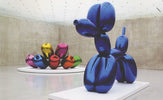
Collecting Contemporary Art
, 2 min reading time

, 2 min reading time
It probably is the most long-term profitable investment that is also living one of its greatest moments, at least, as far as important pieces' auction sales is concerned. And the thing is that contemporary artists haven't ceased to yield records at auctions during the last years despite of the present economic situation. A bubble that burst years ago in the case of the impressionist art and that doesn't seem to be doing it anytime soon in the contemporary art market. The current art buyer wants to explore the new, different and occasionally provocative and is willing to assume some risks to achieve his or her goal.
Throughout the twentieth century history haven't been a few the collectors who, by acquiring works by almost unknown artists of that moment like Paul Cezanne, Pablo Picasso or Henri Matisse, came to owning great works and millionaire collections as a result of an astronomical profitability. Probably one of the best known cases is the Vogel's. This marriage made up by Herb and Dorothy Vogel, him a post office employee and she a librarian, started in the early 60s to earmark part of their incomes to buy artworks by conceptual and minimalist artists. For half a century they acquired works by artists such as Sol LeWitt, Christo, Chuck Close or Robert Mangold and, storing them in their small apartment in New York, they came to owning a formidable collection, one of the most important in the world. The extraordinary of this story about the Vogels is that they never speculated nor sold a single work and only when their apartment was full to the brim they decided to donate their entire collection to Washington's National Gallery of Art and to other United States museums. A great example of true love for art in times of greed and speculation where the only thing that matters are the number.
But not the whole market is represented by these extremely valuable works that have as potential clients great fortunes, in most cases, from emerging countries. There are many the artists and works that during this last years of economic instability have seen their quotation lessen. Without a doubt, this must be taken as an opportunity to acquire artworks at really nice prices.
Building an art collection is an exciting journey but it might impose too much respect and confusion to the one that is about to plunge. It is important to provide the collection with coherence; choose a group of artists, movements or periods may be interesting to overcome the initial disorientation. Studying the artists, evaluate their curriculum and go to their exhibitions will help us to determine the works that we want to be part of our collection. It is also important to compare prices, as it is a very variable market and it is quite common to pay for an artwork an important sum considerably higher than its real value. We must not become obsessed by trends, which often are temporary, we must guide ourselves by our own taste and by the feelings that arise while contemplating a work, we must start up the reasoning and the heart to carry out each of our purchases.